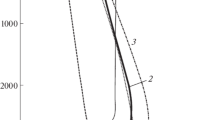Abstract
The structure of thermal convection is determined by the spatial distribution of temperature in the mantle. However, in the literature, when modeling various manifestations of convection, little attention is paid to the degree of correspondence of the temperature distribution calculated in the model with the real temperature in the mantle, and often the temperature distribution is not even presented. In this paper, we analyze the effect on the distribution of temperature and heat fluxes of internal heat sources and the sphericity of the mantle, as well as the effects of dissipation and adiabatic compressibility. Using the Cartesian model leads to a large discrepancy between the calculated distribution of the heat flux and temperature with the observational data. It is shown that the effect of sphericity of the mantle can be approximately interpreted as an additional effective negative internal heat source. At the same time, for the parameters of the modern Earth, it turned out by chance that this effective source is approximately equal in modulus (or rather somewhat more) to the real positive internal heat source (due to radioactivity and secular cooling) and compensates for it. Therefore, the numerous literature results of modeling mantle convection in Cartesian coordinates including internal heat sources are poorly consistent with the actual temperature in the mantle. For the convection model in the modern mantle, this discrepancy can be approximately eliminated by simply eliminating real internal heat sources from the convection equations. The depth distribution of temperature in the mantle of the modern Earth is presented, which is optimally consistent with both the available measurement data (reference points) and the results of refined numerical modeling.






Similar content being viewed by others
REFERENCES
Arevalo, R., Jr., McDonough, W.F., and Luong, M., “The K/U ratio of the silicate Earth: insights into mantle composition, structure and thermal evolution,” Earth Planet. Sci. Lett., 2009, vol. 278, pp. 361–369.
Berry, A.J., Danyushevsky, L.V., O’Neill, H.C., Newville, M., and Sutton, S.R., “Oxidation state of iron in komatiitic melt inclusions indicates hot Archaean mantle,” Nature, 2008, vol. 455, pp. 960– 963.
Davies, J.H. and Davies, D.R., “Earth’s surface heat flux,” Solid Earth, 2010, vol. 1, pp. 5–24.
Faccenda, M. and Dal Zilio, L., “The role of solid-solid phase transitions in mantle convection,” Lithos, 2017, vol. 268–271, pp. 198–224.
Jaupart, C., Labrosse, S., Lucazeau, F., and Mareschal, J.-C., Temperatures, heat, and energy in the mantle of the Earth, in Treatise on Geophysics, Amsterdam: Elsevier, 2015, vol. 7, pp. 223–270.
Katsura, T., Yoneda, A., Yamazaki, D., Yoshino, T., and Ito, E., “Adiabatic temperature profile in the mantle,” Phys. Earth Planet. Inter., 2010, vol. 183, pp. 212–218.
Li, Y., Deschamps, F., and Tackley, P.J., “Effects of the post-perovskite phase transition properties in the stability and structure of premodial reservoirs in the lower mantle of the Earth,” Earth Planet. Sci. Let., 2015, vol. 432, pp. 1–12.
Moresi, L.N. and Gurnis, M., “Constraints on lateral strength of slabs from 3-D dynamic flow models,” Earth Planet. Sci. Let., 1996, vol. 138, pp. 15–28.
Trubitsyn, A.P., “Two stages of thermal evolution of the continental lithosphere,” Izv., Atmos. Oceanic Phys., 2019, vol. 55, pp. 679–686. https://doi.org/10.1134/S0001433819070090
Trubitsyn, V.P., “Continental drift and world ocean level variations,” Izv., Atmos. Oceanic Phys., 2018, vol. 54, pp. 1534–1545.
Trubitsyn, V.P., “Viscosity distribution in the mantle convection models,” Izv., Phys. Solid Earth, 2016, vol. 52, pp. 627–636.
Trubitsyn, V.P. and Trubitsyn, A.P., “Numerical model for the generation of the ensemble of lithospheric plates and their penetration through the 660-km boundary,” Izv., Phys. Solid Earth, 2014, vol. 50, pp. 853–864.
Zhong, S., “Constraints on thermochemical convection of the mantle from plume heat flux, plume excess temperature and upper mantle temperature,” J. Geophys. Res., 2006, vol. 111, B04409. https://doi.org/10.1029/2005JB003972
Author information
Authors and Affiliations
Corresponding author
Ethics declarations
The authors declare no conflict of interest.
Rights and permissions
About this article
Cite this article
Trubitsyn, A.P., Trubitsyn, V.P. Distribution of Temperature and Heat Flux in the Earth: The Influence of Sphericity of the Mantle. Izv. Atmos. Ocean. Phys. 56, 837–844 (2020). https://doi.org/10.1134/S0001433820080101
Received:
Revised:
Accepted:
Published:
Issue Date:
DOI: https://doi.org/10.1134/S0001433820080101




